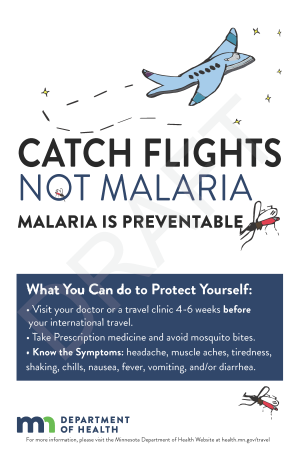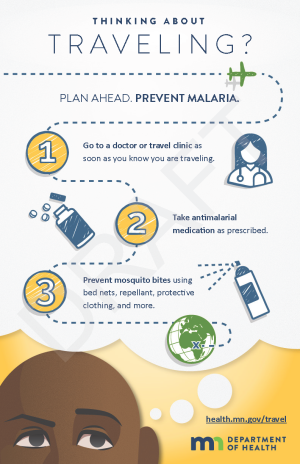Malaria to COVID-19: Model Emerges for Educating Communities
A coalition of Minneapolis College graphic design students, the Minnesota Department of Health (MDH), Minnesota Malaria Community Advisory Board (CAB) and the University of Minnesota (UMN) Center for Global Health and Social Responsibility (CGHSR) developed a unique graphic and social media communication strategy to connect with local communities around international travel and infectious disease.
Origin of the initiative stems from a collaboration between Danushka Wanduragala, MDH Infectious Disease Equity and Engagement unit supervisor, and University of Minnesota Professor Dr. William Stauffer, director, Human Migration and Health, CGHSR.
“Dr. Stauffer and I have been working on a malaria prevention project for six-plus years,” Wanduragala said. “One thing our Malaria Community Advisory Board members suggested was to obtain more education and communications materials that could the catch the eye of travelers going to Africa with malaria prevention messaging.”
The board proposed utilizing outside community-based artists as a resource, particularly with MDH staff consumed by the COVID-19 emergency response.
“We had the idea of having local community artists create materials but didn't get much interest, so I approached several local colleges/universities who had arts programs, and Minneapolis College responded with interest,” Stauffer said. “It benefits the students by providing a professional experience and assists MDH to think out of the box about how best to communicate. It has been so successful for the students and the institutions that I think other public health programs/projects will be interested in this model.”
Kristine Gyolai, Minneapolis College Dean of School of Design and the Arts, embraced the proposal. “I immediately reached out to our faculty Coordinator, Kristine Heykants and Graphic Design faculty member, Samantha Sather,” Gyolai said. “Both are advocates for their students and have lead student collaborations in design and art for us in the past.
“Samantha tied the Department of Health opportunity to her Adobe Illustrator course in the fall, creating a poster and social media campaign project for Malaria prevention. Representatives from MDH and UMN kindly participated in a digital critique of student projects. We value and seek out opportunities for our students to apply their lived experiences and skills they develop in our programs to real world projects, like this.”
Sather elaborated, “A major benefit was our Adobe Illustrator students submitted designs, interacted with clients, and received critique on their work. They experienced articulating their work with clients and how to accept feedback. Out of 25 proposals submitted to the MDH, two students were actually hired to work on the project.”

The MDH Malaria CAB members selected the designs of Tumi Nguyen and Chris Weatherly, putting them under paid contracts.
Enter the MDH graphics and communication staff Katie Hill, MDH Infectious Disease Division communications specialist, and Libby Schultz, MDH digital communications coordinators.
Hill: “The students came to the project with their own unique styles. . . and it was great to see the key messages displayed differently, based on their styles, interests and perspectives. I was blown away by talent we saw in the submissions. It was so refreshing to see elements and bones of a good poster so we could collaborate with the finalist to make sure their design flowed with our guidelines We all feel lucky to have been connected with Minneapolis College and Samantha. Her willingness to provide the students with this experience has turned into final products that will resonate with travelers.”
Schultz: “Working on these types of projects is really great for the students to have on their resume and valuable experience for me as a graphic designer to see where the next generation of students are at in their studies. Working in state government, being the only designer on my team, our work can feel repetitive, so it was great to meet with these students who came with fresh ideas. We will work with the finalists on branding, so it is consistent. They showed us excellent work right off the bat.”

So excellent, in fact, that Sather’s Adobe Illustrator class has been chosen to work on poster and social media images on COVID-19 prevention and travel this spring.
“This next project will focus on reaching people who travel internationally with important COVID-19 consideration,” Wanduragala said. “Messages are a little different for a trip to Cancun versus someone doing three connecting flights to visit friends and family in a rural location back home. There is a need for messaging with COVID not going away anytime soon. Travelers’ health is a growing critical issue.”
MINNESOTA MALARIA COMMUNITY ADVISORY BOARD: The Malaria CAB comprised of community leaders from mostly West African diaspora communities located in Minnesota, as well as a partner CAB in New York City. Other individuals involved with the CAB include representatives from the MDH, the University of Minnesota, Centers for Disease Control and Prevention (CDC), Einstein College of Medicine in New York City, Harvard-Massachusetts General Hospital, consulate/embassy representatives and more.
WHY MALARIA: “Some folks had malaria growing up and developed partial immunity,” Wanduragala said. “Dr. Stauffer tells patients that the longer they’ve been in America, although their heart may belong to their birth country, their blood becomes more and more American. In other words, even if a person had some immunity to diseases like malaria in the past, they could get very sick or possibly even die from malaria when they go back. While cases of malaria are decreasing worldwide, they are increasing in the United States mostly because of increased travel to malaria-endemic countries in Africa and elsewhere. CDC and public health agencies see this as something we should be working on engagement and education in communities to prevent illness and deaths.”
Target audiences for the MDH projects include travelers, travel agents, airlines, airports, consulates, embassies, and various medical or travels clinics.
